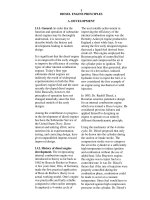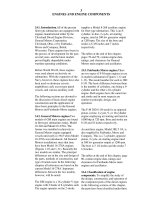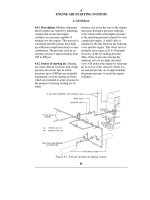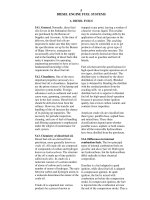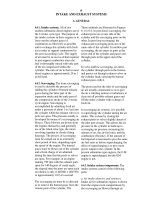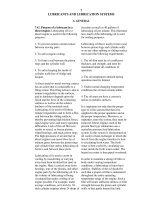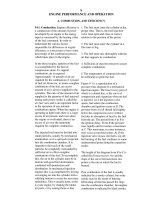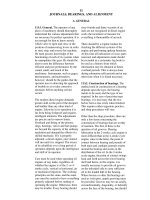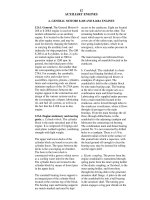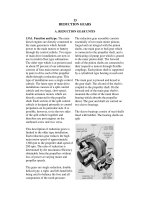Tài liệu Tài liệu Diezel 1410 P7 pdf
Bạn đang xem bản rút gọn của tài liệu. Xem và tải ngay bản đầy đủ của tài liệu tại đây (889.71 KB, 31 trang )
7
LUBRICANTS AND LUBRICATION SYSTEMS
A. GENERAL
7A1. Purpose of a lubricant in a
diesel engine. Lubricating oil in a
diesel engine is used for the following
purposes:
1. To prevent metal-to-metal contact
between moving parts.
2. To aid in engine cooling.
3. To form a seal between the piston
rings and the cylinder wall.
4. To aid in keeping the inside of
cylinder walls free of sludge and
lacquer.
A direct metal-to-metal moving contact
has an action that is comparable to a
filing action. This filing action is due to
minute irregularities in the surfaces,
and its harshness depends upon the
finish and the force of the contacting
surfaces as well as on the relative
hardness of the materials used.
Lubricating oil is used to fill these
minute irregularities and to form a film
seal between the sliding surfaces,
thereby preventing high friction losses,
rapid engine wear, and many operating
difficulties. Lack of this oil film seal
results in seized, or frozen pistons,
wiped bearings, and stuck piston rings.
The high-pressures of air and fuel in
diesel engines can cause blow-by of
exhaust gases between the piston rings
and cylinder liner unless lubricating oil
forms a seal between these parts.
Lubricating oil is used to assist in
cooling by transferring or carrying
away heat from localized hot spots in
the engine. Heat is carried away from
bearings, tops of the pistons, and other
engine parts by the lubricating oil. It is
the volume of lubricating oil being
circulated that makes cooling of an
engine possible. For example, under
average conditions, an 8-inch by 10-
inch cylinder requires about 24 drops o
f
circulate as much as 40 gallons of
lubricating oil per minute. This illustrates
how much of the lubricating oil is used
for cooling purposes.
Lubricating oil that is used to form a seal
between piston rings and cylinder walls
or on any other rubbing or sliding surface
must meet the following requirements:
1. The oil film must be of a sufficient
thickness and strength, and must be
maintained under all conditions of
operation.
2. The oil temperature attained during
operation must be limited.
3. Under normal changing temperature
conditions the oil must remain stable.
4. The oil must not have a corrosive
action on metallic surfaces.
It is important not only that the proper
type of oil be selected but that it be
supplied in the proper quantities and at
the proper temperature. Moreover, as
impurities enter the system, they must be
removed. Diesel engines used in the
present fleet type submarines use a
centralize pressure feed lubrication
system. In this system is incorporated an
oil cooler or heat exchanger in which the
hot oil from the engine transfers its heat
to circulating fresh water. The fresh
water is then cooled by circulating sea
water inside the fresh water cooler. The
heated sea water is then piped overboard.
In order to maintain a strong oil film or
body under varying temperature
conditions, a lubricating oil must have
stability. Stability of the oil should be
such that a proper oil film is maintained
throughout the entire operating
temperature range of the engine. Such a
film will insure sufficient oiliness or film
strength between the piston and cylinder
walls so that partly burned fuel and
oil per minute for lubrication of the
cylinder wall. About 30 drops of oil per
minute normally will lubricate a large
bearing when the engine is running at
high speed. Yet some engines
exhaust gases cannot get by the piston
rings to form sludge.
7A2. Chemistry of lubricating oils. As
explained in Chapter 5, lubricating oil is
the product of the fractional distillation
of crude
129
petroleum. Lubricating oils obtained
from certain types of crude petroleum
are better adapted for diesel engine use
than others, therefore it was formerly
highly important that the oils be
manufactured from crudes that
contained the smallest possible
percentage of undesirable constituents.
Modern refining methods, by
employing such processes as
fractionation, filtration, solvent
refining, acid treating, and
hydrogenation have, however, made it
possible to produce acceptable
lubricating oils from almost any type of
crude oil.
7A3. Properties of lubricating oils. To
insure satisfactory performance a
lubricating oil must have certain
physical properties which are
determined by various types of tests.
These tests give some indication of
how the oil may perform in practice,
although an actual service test is the
only criterion of the quality of the oil.
Some of the tests by which an oil is
checked to conform to Navy
specifications are as follows:
1. Viscosity. The viscosity of an oil is
the measure of the internal friction of
the fluid. Viscosity is generally
considered to be the most important
property of a lubricating oil since
friction, wear, and oil consumption are
more or less dependent on this
characteristic.
2. Pour point. The lowest temperature
at which an oil will barely pour from a
container is the pour point. High pour
point lubricating oils usually cause
difficulty in starting in cold weather
due to the inability of the lubricating oil
5. Corrosion. The tendency of an oil to
corrode the engine parts is known as the
corrosive quality of the lubricating oil.
The appearance of a strip of sheet copper
immersed in oil at 212 degrees F for 3
hours formerly was thought to indicate
the corrosive tendency of an oil. This
test, however, is not necessarily a
criterion of the corrosive tendency of the
newer compounded oils, some of which
do darken the copper strip but are not
corrosive in service. Corrosive oil has a
tendency to eat away the soft bearing
metals, resulting in serious damage to the
bearing.
6. Water and sediment. Water and
sediment in a lubricating oil normally are
the result of improper handling and
stowage. Lubricating oil should be free
of water and sediment after leaving the
purifier and on arriving at the engine.
7. Acidity or neutralization number. The
neutralization number test indicates the
amount of potassium hydroxide, in
milligrams, necessary to neutralize one
gram of the oil tested. It is, therefore,
proportional to the total organic and
mineral acid present. The results are apt
to be misleading or subject to incorrect
interpretation, since the test does not
distinguish between corrosive and
noncorrosive acids, both of which be
present. The chief harm resulting from
the presence of organic acid, which is
noncorrosive, is its tendency to emulsify
with water. This emulsion picks up
contaminants and is a sludge which may
interfere with proper oil circulation. The
neutralization number of new oils is
generally so low as to be of no
importance.
8. Emulsion. The ability of an oil to
pump to pump oil through the
lubricating system.
3. Carbon residue. The amount of
carbon left after the volatile matter in a
lubricating oil has been evaporated is
known as the carbon residue of an oil.
The carbon residue test gives an
indication of the amount of carbon that
may be deposited in an engine.
Excessive carbon in an engine leads to
operating difficulties.
4. Flash point. The lowest temperature
at which the vapors of a heated oil will
flash is the flash point of the oil. The
flash point of an oil is the fire hazard
measure used in determining storage
dangers. Practically all lubricating oils
have flash points that are high enough
to eliminate the fire hazard during
storage in submarine, tender, or base
stowage facilities.
separate from water in service is known
as the emulsibility of the lubricating oil.
The emulsibility of a new oil has little
significance. Two oils that have different
emulsifying tendencies when new, may
have the same emulsion tendency after
being used in an internal combustion
engine for a few hours. The emulsibility
of an oil that has been in use for some
time is important.
9. Oiliness or film strength. The ability o
f
a lubricating oil to maintain lubrication
between sliding or moving surfaces
under pressure and at local high
temperature areas is known as the
oiliness or film strength of the oil. Film
strength is the result of several oil
properties, the most important being
viscosity.
130
10. Color. The color of a lubricating oil
is useful only for identification
purposes and has nothing to do with
lubricating qualities. If the color of a
nonadditive oil is not uniform, it may
indicate the presence of impurities;
however, in additive lubricating oils, a
nonuniform color means nothing.
11. Ash. The ash content of an oil is a
measure of the amount of
noncombustible material present that
would cause abrasion or scoring of
moving parts.
12. Gravity. The specific gravity of an
oil is not an index of its quality, but is
useful for weight and volume
computation purposes only.
13. Sulphur. The test for sulphur
indicates the total sulphur content of
the oil and does not distinguish
between the corrosive and noncorrosive
forms. A certain amount of
noncorrosive sulphur compounds is
allowable, but the corrosive compounds
must be eliminated because of their
tendency to form acid when combined
wear. In the bearings, however, the
temperatures are lower and the rotation
tends to create a fluid film permitting a
lighter oil to be used. When a single
lubricating system supplies oil to
cylinders and bearings, it is necessary to
compromise on an oil that will do the
best job possible in both places. All
modern submarine diesel engines are of
the latter type, having a single lubricating
system.
Temperature, however, is not the only
consideration in selecting an oil of the
proper viscosity. Clearances, speed, and
pressures are also important factors.
Their effects on required viscosity may
be summarized as follows:
1. Greater clearances always require
higher viscosity.
2. Greater speed requires lower viscosity.
3. Greater load requires higher viscosity.
The oil selected for a diesel engine is
therefore a compromise between a high-
and a low-viscosity oil. Most high-speed
with water vapor.
14. Detergency. The ability of an oil to
remove or prevent accumulation of
carbon deposits is known as its
detergent power.
7A4. Viscosity of lubricating oils. The
viscosity of a lubricating oil at the
operating temperature in the engine is
one of the most important
considerations in selecting oil, since
viscosity is the characteristic that
determines film thickness and the
ability to resist being squeezed out. The
viscosity of an oil changes with
temperature. Therefore, the viscosity
should be measured at the operating
temperatures of that particular part of
the engine which the oil is to lubricate.
From the viewpoint of lubrication,
engines can be considered in two
classes, those in which the cylinders
and bearings are lubricated separately,
and those in which only one lubricating
system is used. If there are separate
lubrication systems for cylinders and
bearings, it is possible to use two
grades of oil, the heavy one for
cylinders and a medium one for
bearings. The operating temperature to
which the oil is subjected in the
cylinders is naturally much higher than
in the bearings. Also the motion in a
cylinder is sliding, and a heavier oil is
required to provide sufficient body to
prevent metallic contact and
engines run better using low-viscosity
oils, but the viscosity must not be so low
that the oil film wedge is too thin for
efficient lubrication. On the other hand,
oil of a greater viscosity than necessary
should not be used because:
1. An oil of too great a viscosity
increases starting friction.
2. Increased friction raises oil
temperatures, and thereby promotes
oxidation.
3. The more viscous oils usually have a
higher carbon residue.
4. An oil of too great a viscosity places
an overload on the lubricating oil pump
with a possible inadequate supply
reaching some moving parts.
For practical purposes the viscosity is
determined by noting the number of
seconds required for a given quantity of
oil to flow through a standard orifice at a
definite temperature. For light oils the
viscosity is determined at 130 degrees F,
and for heavier oils at 210 degrees F. The
Saybolt type viscosimeter with a
Universal orifice is used for determining
the viscosity of lubricating oils. The
longer it takes an oil to flow through the
orifice, at a given temperature, the
heavier or more viscous the oil is
considered.
7A5. Tests. Viscosity tests are frequently
conducted on board ship to determine the
amount of dilution caused by leakage of
fuel oil
131
into the lubricating oil system. The test
is made with a Visgage (Figure 7-1), a
small instrument consisting of two
glass tubes, each of which contains a
steel ball, and a scale calibrated to
indicate seconds Saybolt Universal
(SSU) at 100 degrees F. One of the
glass tubes is sealed and contains oil of
a known viscosity. The other has a
nozzle at one end and contains a
plunger with which the oil to be tested
is drawn into the tube. The instrument
should be warmed by hand for a few
minutes so that the temperature of the
sample oil will be the same as that of
the oil sealed in the master tube. Then,
starting with both steel balls at the zero
marking on the scale, the instrument is
tilted so that the balls will move
through the oil. On the instant that the
leading ball reaches the 200 marking at
the end of the scale, the position of the
other ball in relation to its scale is
noted. That reading indicates the
viscosity of the sample oil in SSU at
100 degrees F direct.
The percentage of dilution of the
lubricating oil by the diesel fuel oil is
determined by use of the viscosity
blending chart. This chart is essentially
a graph of oil viscosity against
percentage. Both right and left vertical
boundary lines are marked in terms of
viscosity SSU. The horizontal lines are
divided into percentages from 0 to 100
percent. In using the viscosity blending
chart, a line is drawn between the
lubricating oil viscosity marked on the
left vertical boundary line and the
diesel fuel oil viscosity marked on the
right vertical boundary line. This line
represents only one particular
lubricating oil viscosity. Figure 7-2 is
an expanded portion of one section of a
viscosity blending chart with lines
drawn in for Navy symbol lubricating
oils most commonly used. To
determine the percent dilution of a
lubricating oil, the viscosity of a test
sample of the used oil is obtained,
usually with a Visgage. The
intersection of this valve on the chart
with the line representing the Navy
symbol oil in use gives a direct reading
Figure 7-1. Visgage.
As shown on the chart, the dilution is
approximately 5 percent.
7A6. Detergent lubricating oils.
Detergent or additive oils as they are
usually called, consist of a base mineral
oil to which chemical additives have
been added. The additive agent has the
following beneficial effect on the
performance of the base lubricant:
1. It acts as an oxidation inhibitor.
2. It improves the natural detergent
property of the oil.
3. It improves the affinity of the oil for
metal surfaces.
For Navy use, heavy duty detergent
lubricating oils of the 9000 series are
used in most diesel installations. The use
of these oils in a diesel engine results in a
reduction in ring sticking and gum or
varnish formation on the piston and other
parts of the engine. In dirty engines, a
heavy duty detergent oil will gradually
remove gummy and carbonaceous
deposits. This material being carried in
suspension in the oil will
of the percentage of dilution on the
horizontal scale.
Example:
SSU at 100 degrees F
New lubricating oil, viscosity
9250
550
Diesel fuel oil 37
Used lubricating oil (measured by
Visgage)
420
132
Figure 7-2. Section of viscosity blending chart.
133
tend to clog the oil filters in a relatively
short time. Normally, a dirty engine
will be purged with one or two fillings
2. Carbon caused by the evaporation of
oil on a hot surface, such as the underside
of a piston.
of the sump, depending upon the
condition of the engine and the quantity
of the oil used. During the cleaning-up
process, the operator should drain the
sump and clean the filter if the oil gage
indicates an inadequate oil flow.
In using additive or detergent type oils
the following points should be
considered:
1. All Navy approved oils are miscible.
However, to obtain the maximum
benefit from additive oils, they should
not be mixed with straight mineral oils
except in emergencies.
2. Detergent oils on the approved list
are not corrosive. Should ground
surfaces be found etched, or bearings
corroded, it is probable that
contamination of the lubricant by water
or partially burned fuel is responsible.
It is important that fuel systems be kept
in good repair and adjustment at all
times. The presence of water or
partially burned fuel in lubricating oil is
to be avoided in any case, whether
mineral oil or detergent oil is used.
However, small quantities of water in
the Navy symbol 9000 series oils are no
more harmful than the same amount of
water in straight mineral oils. They will
not cause foaming nor will the
additives in the oils be precipitated
7A7. Sludge. Almost any type of
gummy or carbonaceous material
accumulated in the power cylinder is
termed sludge. The presence of sludge
is dangerous for several reasons:
1. Sludge may clog the oil pump screen
or collect at the end of the oil duct
leading to a bearing, thereby preventing
sufficient oil from reaching the parts to
be lubricated.
2. Sludge will coat the inside of the
crankcase, act as an insulation, blanket
the heat inside the engine, raise the oil
temperature, and induce oxidation.
3. Sludge will accumulate on the
underside of the pistons and insulate
3. Gummy, partially burned fuel which
gets past the piston rings.
4. An emulsion of lubricating oil and
water which may have entered the
system.
Sludge is often attributed to the breaking
down of lubricating oil, but generally this
is not true.
Sludge gathers many dangerous
ingredients, such as dust from the
atmosphere, rust caused by water
condensation in the engine, and metallic
particles caused by wear, which
contribute to premature wear of parts and
eventual break down of the engine.
7A8. Bearing lubrication. The motion
of a journal in its bearing is rotary, and
the oil tends to build up a wedge under
the journal. This oil wedge lifts the
journal and effectively prevents metallic
contact. The action of the oil film is
explained in Figure 7-3 which illustrates
the hydrodynamic theory of lubrication.
This theory, involving the complete
separation of opposing surfaces by a fluid
film, is easily understood when the
mechanism of film formation in a plain
bearing is known. The diagram shows
first the bearing at rest with practically
all of the lubricant squeezed from the
load area. Then, as rotation begins, an oil
film is formed which separates the
journal from the bearing. When rotation
starts with the clearance space filled with
oil there is a tendency for the journal to
climb or roll up the bearing as a wheel
rolls uphill. As the center of the bearing
does not coincide with the center of the
journal, the clearance space is in the form
of a crescent with its wedge-shaped ends
on either side of the contact or load area.
Because of the fact that oil is adhesive
and sticks to the journal, rotation causes
oil to be drawn into the wedge-shaped
space ahead of the pressure area. As the
speed of rotation increases, more oil is
carried into the wedge by the revolving
journal, and sufficient hydraulic pressure
is built up to separate completely the
journal and bearing. When this film has
them, thereby raising piston
temperatures.
4. Sludge in lubricating oil also
contributes to piston ring sticking.
Sludge is usually formed by one or a
combination of the following causes:
1. Carbon from combustion chambers.
formed, the load on the journal tends to
134
Figure 7-3. Formation of bearing oil film.
cause it to drop to the lowest point.
However, the pressure built up in the
converging film ahead of the pressure
area tends to push the journal to the
other side of the bearing. The wedging
action of the oil builds up a film
pressure of several hundred pounds per
square inch. The oil pump pressure,
however, need only be sufficient to
insure an adequate supply of oil to the
bearings. All oil openings should be in
the low-pressure section of the bearing
in order to keep the lubricating oil
pump pressure to a minimum. Diesel
bearing pressures normally are not
much over 1000 psi, and an oil film of
straight mineral oil will usually
withstand pressures of over 5000 psi.
The viscosity required to produce the
proper oil film thickness depends on
several factors. A rough or poor bearing
needs a more viscous oil than a smooth,
properly fitted bearing. Bearing
clearances should always be enough to
form an oil film of the proper thickness.
Excessive bearing clearances reduce
the oil pressure and only an excessively
viscous oil will stay between the
bearing surfaces. The greater the load
on the bearing, the greater the oil
viscosity required to carry the load. On
the other hand, higher speeds permit a
result from either a lack of sufficient
lubricant or the use of an improper
lubricant. Lack of lubricant may be due
to excessive bearing wear, excessive
bearing side clearance, low oil level, low
oil pressure, and plugged oil passages.
Failure, due to the use of an improper oil,
results not only from incorrect original
lubricant, but more frequently from
continued use of an oil that should be
replaced. Viscosity, in particular, is
subject to change due to bearing
temperature variation, dilution by
unburned fuel, and oxidation. Bearing
temperature variation is controlled by the
proper operation of the cooling system.
Lubricating oils may become corrosive in
service, due to contamination by products
of combustion or to inherent
characteristics of the oil itself. Bearing
corrosion is, of course, most likely to
occur at high temperatures.
To insure against corrosion, the
lubricating oil should be changed
frequently, especially if oil temperatures
are high or if easily corroded bearing
materials are used. A pitted bearing
usually indicates corrosion, which may
be due to fuel, lubricant, or water.
7A9. Cylinder lubrication. The oil
supplied to the cylinders must perform
reduction in viscosity since the high
shaft rotation helps build up the oil film
pressure.
Bearing trouble and failure are usually
attributable to improper lubrication.
This may
the following functions:
1. Minimize wear and frictional losses.
2. Seal the cylinder pressures.
3. Act as coolant.
135
If no lubricant were employed, the
metal surfaces would rub on one
another, wearing away rapidly and
producing high temperatures. The
cylinder oil must prevent, as much as
possible, any metallic contact by
maintaining a lubricating film between
the surfaces. Since oil body, or
viscosity, determines the resistance of
the oil against being squeezed out, it
might seem that the thicker the oil, the
better. This holds true in regard to
wear, but there are other factors to be
considered The body of the oil which
prevents the film from being removed
from the rubbing surfaces also provides
a drag, resisting motion of the piston
and reducing the power output of the
engine. In addition, an oil that is too
heavy does not flow readily, and spots
on the cylinder walls remote from the
point of lubrication may remain dry,
causing local wear. Very heavy oils
tend to remain too long on the piston
lands and in ring grooves. While this
condition may result in lower oil
consumption, it will eventually cause
gumming due to oxidation of the oil,
and the final result will be sticky rings.
For cylinder lubrication, therefore, it is
desirable to use the lightest possible oil
that will still keep the cylinder walls
and piston lubricated. Use of a light oil
will result in faster flow of the oil to the
parts requiring lubrication, reduce
starting wear, and minimize carbon
deposits. This will result in lower fuel
consumption, lower temperatures,
longer periods between overhauls, and
finally, lower total operating costs The
lubricating oil consumption will
probably be slightly higher, but the
saving in fuel alone will more than
make up for the additional lubricating
oil expense.
The oil aids in cooling by transmitting
heat from the piston to the cylinder wall.
To fulfill this requirement the oil should
be as light as possible, since with light
oils there is more movement in the oil
film, a condition which aids the transfer
of heat.
7A10. Navy specifications and symbols
for lubricating oil. The symbol numbers
used in Navy lubricating oil classification
tables are for the ready identification of
the oils as to use and viscosity. Each
number consists of four digits, of which
the first classifies the oil according to its
use, and the last three indicate its
viscosity. For example, the symbol 2250
indicates that the oil is a force feed oil
(viscosity measured at 130 degrees F)
and has a viscosity of 250 seconds
Saybolt Universal. The following is a list
of the classification of lubrication oils as
to use:
Series Classification Navy
Symbol
Examples
1000 Aviation oils 1065,
1080,
1100,
1120, 1150
2000 Forced feed oils
(viscosity measured
at 130 degrees F)
2075,
2110,
2135, 2190
3000 Forced feed oils
(viscosity measured
at 210 degrees F)
3065,
3080, 3100
4000 Compound marine
engine oils
4065
5000 Mineral marine
engine and cylinder
wall oils
5065,
5150, 5190
6000 Compounded steam 6135
The sealing function of the oil is tied in
with its lubricating property. In order to
make a good seal, the oil must provide
a film that will not be blown out from
between the ring face and the cylinder
wall nor from the clearance space
between the ring and the sides and back
of the ring groove. The effectiveness of
this seal depends partly upon the size o
f
the clearance spaces. With a carefully
fitted engine, in which clearances are
small, a light oil can be used
successfully. If the oil is heavy enough
to provide a good seal, it will have a
good margin of safety for the
requirement usually stressed, that of
preventing metallic contact.
cylinder oil (tallow)
7000 - -
8000 Compounded air
compressor
cylinder oils
8190
9000 Compounded or
additive type heavy
duty lubricating oils
(viscosity measured
at 130 degrees F)
9110,
9170,
9250,
9370, 9500
136
The most common lubricating oil
classification is that known as the SAE
(Society of Auto motive Engineers)
classification. Since the SAE numbers
are more generally used outside of the
Navy, a comparison showing the
viscosity limits of the various numbers
is given in the accompanying table.
SAE
No.
Viscosity Seconds Saybolt
At 130
degrees F
At 210
degrees F
10 90-120
20 120-185
30 185-255
40 255- 80
50 80-105
60 105-125
70 125-150
B. LUBRICATING SYSTEMS
7B1. Basic requirements of a
lubricating system. Lubrication is
perhaps the most important single
factor in the successful operation of
diesel engines. Consequently, too much
emphasis cannot be placed upon the
importance of the lubricating oil system
and lubrication in general. It is not only
important that the proper type of oil be
used, but it must be supplied to the
engine in the proper quantities, at the
proper temperature, and provisions
must be made to
remove any impurities as they enter the
system. In general, the basic
requirements that a lubricating system
must meet to perform its functions
satisfactorily are:
1. An effective lubricating system must
correctly distribute a proper supply of oil
to all bearing surfaces.
2. It must supply sufficient oil for cooling
purposes to all parts requiring oil
cooling.
3. The system must provide tanks to
Figure 7-4. General arrangement of lubricating off tanks.
137
collect the oil that has been used for
lubrication and cooling, so that it can
be recirculated throughout the system.
4. The system must include coolers to
maintain the oil temperature within the
most efficient operating temperature
range.
5. In order to exclude dirt and water
from the working parts of the engine,
filters and strainers must be included in
the system to clean the oil as it
circulates.
6. Adequate facilities must be provided
on the ship for storing the required
quantity of lubricating oil necessary for
extensive operation and for transferring
this oil to the engine lubricating
systems as needed.
7B2. Ship's lubricating oil tanks and
sumps. A typical lubricating oil system
installation on recent submarines
consists of three normal lubricating oil
tanks and one reserve lubricating oil
tank. These tanks are located inside the
pressure hull adjacent to the
engineering spaces and have
approximately the following capacities:
Normal lubricating oil
tank No. 1
1534
gallons
Normal lubricating oil
tank No. 2
973
gallons
Normal lubricating oil
tank No. 3
1092
gallons
Reserve lubricating oil 1264
A filling connection is provided on the
main deck to a five-valve filling and
transfer manifold located on the
starboard side of the forward engine
room. This manifold is connected not
only to the filling connection, but also
directly to each of the normal lubricating
oil tanks and the reserve lubricating oil
tank. The oil to fill the tanks normally is
passed through a strainer before it
reaches the filling and transfer manifold.
This oil strainer may be bypassed. A
drain from the bottom of the strainer
makes it possible to drain out any salt
water that might have leaked into the
filling line through the outboard filling
connection.
The tanks are provided with vents and air
connections from the 225-pound air
service lines. By the use of these lines,
lubricating oil may be blown from any
lubricating oil storage tank to any other
lubricating oil tank. Oil to be discharged
may be blown or pumped overboard
through the deck filling connection or
through a hose connection in the filling
line.
7B3. Operation of engine lubricating
oil system. Oil is drawn from the sump
tank by the attached lubricating oil pump.
The discharge from this pump passes
through the lubricating oil strainer.
Between the discharge side of the pump
and the strainer is a relief valve built
integral with the pump. From the strainer
the oil is carried to the lubricating oil
cooler and thence to the engine main
lubricating oil headers. The strainer is
tank gallons
In addition to these storage tanks, there
is a sump tank under each main engine
and under each of the two reduction
gears. These tanks collect the oil as it
drains from the engine oil pans. The
sump tanks are always partially filled in
order to insure a constant supply of oil
to the lubricating oil pumps. As, the
sump tanks are never completely filled
with lubricating oil, their capacity is
usually indicated as 75 percent of the
actual total tank capacity. The
approximate capacities of the various
sump tanks (at 75 percent) are:
Main engine sump tanks
Nos. 1, 2, 3, 4
382
gallons
each
Motor and reduction gear
lubricating oil sumps Nos.
1, 2
165
gallons
each
always placed forward of the cooler in
the system because, if the temperature of
the lubricating oil is higher, its filtering
efficiency will be greater and the power
necessary to force the oil through the
strainer will be less.
In most installations the lubricating oil
goes from the main lube oil headers to
the engine main bearings and thence to
the connecting rod bearings. The oil then
passes through a drilled hole in the
connecting rod up to the piston pin
bearing which it lubricates and sprays out
onto the under surface of the piston
crown. Next, it drains down into the oil
drain pan, carrying away from the piston
much of the heat caused by combustion.
From the oil pan, the oil drains to the
engine sump tank from which it is
recirculated
138
